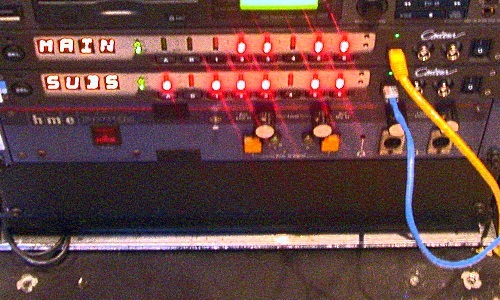
Nicholas Radina: I always try to aim for a natural response – some may call this “flat” or “true.” The goal is to understand if it’s possible to create the neutral response, and if not, how to compensate. With the steady challenges of room response, loudspeaker positioning and audience location, I’d much rather start with the system exciting the space with as little extraneous influence as possible.
In regards to a sub bump, I think it solely depends on the style of music. Too often I hear such an uneven tilt of low end when it’s not necessary for the music. If this energy is required for impact and translation of the artist, then yes, the balance of the system should favor what’s needed.
Dave Natale: I’ve said many times that I have a very non-standard, unorthodox or just plain crazy way that I approach audio; however, it seems to have worked out for me. That said, I would not recommend that anyone adopt this technique as it may get you fired or worse.
As you may or may not know (or care), I use track 2 (“Gone Buttlefishin”) on the Sheffield Lab CD (#23) James Newton-Howard and Friends. (See Dave’s article here for more on this topic.)
I use a third-octave EQ with faders on it, like an old Klark-Teknik DN 27, DN 30/30, DN 360, or a TC Electronic 1128 with the 6032 remote head. I start with the 20, 30, 40, 50, 60 and 80 Hz faders on the graphic set to flat or zero, whichever you prefer, and the rest of the faders (100 Hz to 16 kHz) cut 15 dB or the maximum amount… pulled all the way down. With the EQ set this way what we’re hearing is the maximum amount of low end that the system can muster by virtue of everything but the low end being cut by 15 dB.
I start by listening to the Newton-Howard track through one side of the PA only. It can either be the left or the right side, depending on which side I’m closer to. I then add back in the remaining frequencies as I deem them necessary. It’s kind of like “seasoning to taste.”
I’m not a huge fan of 160, 315, and 630 Hz. These frequencies never did any drum in the known universe any good. My other least favorite higher frequencies are 2, 2.5 and 3.15 kHz. They just hurt your ears.
This technique has worked for me on all PA systems in all sorts of venues – from clubs to stadiums and larger – for the last 40 years. There is no rule book in audio, and if your style, whether it be conventional or unorthodox gets you there, then it works for you.
Samantha Potter: I aim for a flat response, but I find myself needing a little extra sub bump on occasion to push the low-end SPL. It varies so greatly from gig to gig, but I’d like to think I strive for a flat system response. In most situations, a sub bump is adding a really nice flavor to the mix without me having to individually adjust different channels (although putting the subs on an aux would compensate).
I don’t like doing too much of any one thing to the system tuning as I use that as a corrective approach. If I went in and the system was entirely flat, I would feel like I need to push my kick/bass/floor tom a little harder than normal. Perhaps this is our conditioning in this hyper-bass world we live in. I don’t mix for myself, though. I mix for the purpose and the audience.
Michael Lawrence: This is a tricky one because there’s a few different layers to it. First off, the PA is part of our transmission system. Once the mix leaves the console and crosses the McCarthy “Art/Science Line,” I don’t want anything downstream to alter or editorialize my signal; I just want it transmitted faithfully. This is a no-brainer for amplifiers and cables, but for some reason loudspeakers are still up for debate.
So to start with, I’ll take a flat, linear system that reproduces as closely as possible whatever I send it from my console – and does so over the entire audience area. As soon as we overlay that with the fact that music of most genres pretty consistently tends to have a spectrum that’s tilted towards the low, we see that the spectral tilt of a sound system becomes simply a matter of convenience: the FOH engineer is going to do whatever needs to be done to get the mix to sound a certain way, and it’s probably more convenient to tilt the whole PA rather than try to tilt everything in the mix.
This “self calibrating” aspect of the mix position means that it’s simply a game of how many filters are needed to accomplish a certain sound, and if we can do that with a filter on the entire system EQ rather than on each channel strip, that’s just simpler and easier.
So to quote another audio luminary, my final answer is, “it depends.”
Check out the rest of the Roundtable articles on PSW here.
